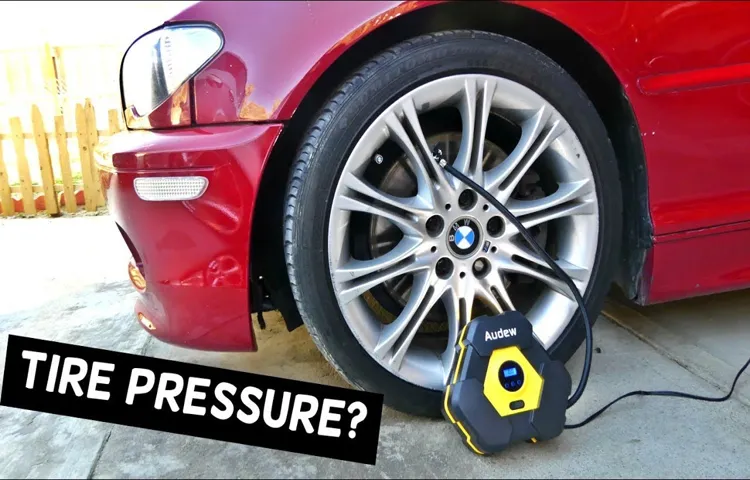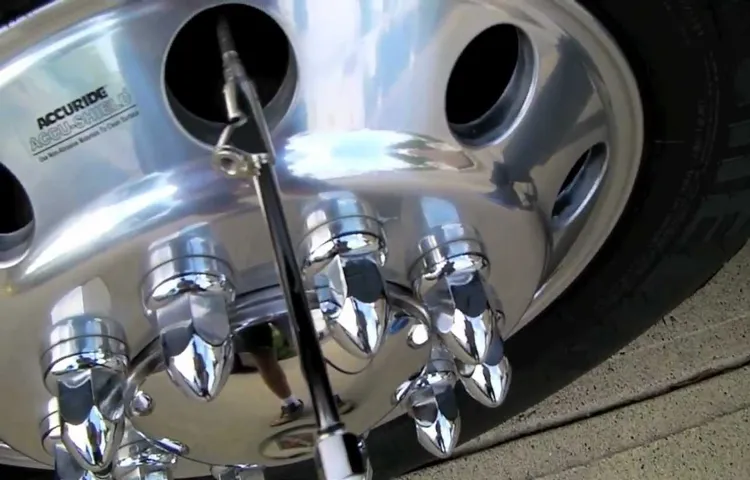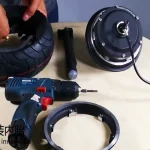Have you ever struggled with inflating your inside dually tires? It can be a frustrating experience, but fear not because we are here to your rescue! In this step-by-step guide, we will show you everything you need to know about inflating inside dually tires with ease. First things first, let’s explain what dually tires are. A dually truck has two tires on each side of the rear axle, and the inside tire is called the inside dually tire.
These tires are typically inflated to a higher PSI than regular tires to accommodate the additional weight they must carry. Now, onto the process of inflating inside dually tires. The first step is to check the recommended PSI for your tires, which can be found in your vehicle manual or on the tire itself.
It’s essential to not overinflate your tires as it can cause them to burst and lead to serious safety hazards. Once you have determined the recommended PSI, you can start inflating your tires. Begin by removing the valve cap and attaching the air hose.
Make sure the hose is secured tightly to avoid any air leaks. Slowly begin pumping air and check the tire pressure frequently with a tire pressure gauge to ensure it’s not overinflated. Repeat the process for the remaining inside dually tires on your vehicle.
It’s also essential to inspect your tires for any damage, such as cuts or bulges, while you’re inflating them. In conclusion, inflating inside dually tires can be a simple process as long as you follow the recommended PSI and inflate the tires slowly and carefully. And remember, safety should always come first when it comes to your tires.
Table of Contents
Gather Your Materials
Inflating inside dually tires can seem like a daunting task, but with the right materials and techniques, anyone can do it. Before you begin, gather all the necessary materials: a high-quality air compressor, an air chuck, and a tire pressure gauge. It’s essential to use a high-quality compressor to ensure that you’re getting enough air pressure into the tire.
An air chuck is needed to attach the compressor hose to the tire valve, while a tire pressure gauge will help you to monitor the tire pressure accurately. Once you have all of your materials ready, you’re good to go. It’s important to note that when inflating a dually tire, it’s recommended to remove the outer wheel and inflate the inner tire first.
Afterward, you can reattach the outer wheel and inflate that tire to the recommended pressure. By following these simple steps and using the right materials, inflating inside dually tires can be a breeze.
What You’ll Need to Get Started
If you’re thinking about starting a new project, it’s essential to gather all the necessary materials so that you can get started without any delays. Depending on what you’ll be making, your list of materials may vary, so make sure you have a clear plan in mind. Some essential items that most projects will require include measuring tools, cutting tools, adhesives, and materials like paper, fabric, or wood.
You may also need specific supplies like paint, brushes, or needles and thread depending on the project you’re undertaking. Gathering your materials can be an exciting part of the process, and you can even get creative by using materials in unique ways. Remember, the more organized you are, the smoother the process will be.
So, make a list of what you’ll need and gather everything before you begin. By doing this, you can avoid any unnecessary trips to the store and ensure that you have everything you need to complete your project successfully.

Locate the Valve Stem
If you’re looking to inflate your inside dually tire, the first step is to locate the valve stem. This can be a bit tricky, as it may be hidden or difficult to reach. In most cases, you’ll need to remove the wheel cover or hubcap to access the valve stem.
Once you’ve found it, you can use a tire pressure gauge to check the current pressure and make adjustments as needed. It’s important to remember that overinflating your tires can be just as dangerous as underinflating them, so be sure to follow the manufacturer’s recommended pressure levels. In addition to improving safety and performance, properly inflated tires can also help maximize fuel efficiency and extend the life of your tires.
So, whether you’re getting ready for a long road trip or just need to make a quick adjustment, taking the time to locate and inflate your inside dually tire can make a big difference on the road.
Finding the Valve on a Dually Tire
When it comes to checking the air pressure in your dually tires, it’s essential to locate the valve stem. The valve stem is a small, metal protrusion usually located near the rim of the wheel. In most cases, you can find it by looking for a small cap that covers the valve stem.
Once you’ve located the valve stem, you can use a tire pressure gauge or an air compressor to fill your tires to the recommended pressure level. It’s crucial to ensure that you check your tire pressure regularly as driving on underinflated tires can reduce your fuel efficiency and increase the risk of a blowout. By taking the time to locate the valve stem and check your tire pressure, you’re not only improving your vehicle’s performance, but you’re also prioritizing your safety on the road.
Remove the Valve Stem Cap and Deflate the Tire
Inflating the inside dually tire can be tricky, but with the right steps, it’s not impossible. The first thing you want to do is remove the valve stem cap and deflate the tire. This ensures you start with a flat tire, which makes it easier for you to reach inside and inflate the inner tire.
Unscrew the cap on the valve stem, and press down on the valve core in the center of the stem to release the air. Be sure to completely deflate the tire to give yourself enough room to work with. While doing this, make sure you have an accurate tire gauge handy to check the air pressure.
Once you have fully deflated the tire, you can move on to the next step of inflating the inner tire. Remember, taking your time is essential to avoid any mishaps and ensure a smooth inflation process.
Preparing the Tire for Inflation
When preparing a tire for inflation, the first step is to remove the valve stem cap and deflate the tire. This may seem like a simple task, but it’s important to do it correctly to ensure a proper inflation process. To remove the valve stem cap, simply unscrew it by turning it counterclockwise.
Make sure to keep the cap in a safe place while you’re working on the tire. Next, use a tire gauge or pressure monitoring system to check the current pressure and then release it by pressing down on the center pin in the valve stem. It’s important to deflate the tire completely before attempting to inflate it, as this will ensure an accurate reading of how much air the tire needs.
Once you have deflated the tire, you can move on to the next step of preparing it for inflation. Remember, taking the time to properly prepare your tire will help you avoid potential problems down the road and keep you safe on the road.
Attach the Air Hose
When it comes to inflating the inside dually tire, it’s important to attach the air hose properly. First, make sure the tire valve stem is free of debris and the valve cap is removed. Then, attach the air chuck to the valve stem and ensure a secure connection.
Next, turn on the air compressor and check the tire pressure gauge to ensure you’re inflating to the proper psi. And remember, don’t overinflate the tire as this can cause damage and potentially lead to a blowout on the road. By following these simple steps and taking your time, you can safely and effectively inflate your inside dually tire.
Connecting the Hose to the Valve Stem
Connecting the air hose to the valve stem on your tire can seem like a daunting task, but with a little patience and practice, you’ll be able to do it with ease. Firstly, you’ll need to make sure the air hose is clean and free from dirt and debris. Next, ensure the valve stem is accessible and free from any obstacles.
Once you’ve inspected both the hose and stem, it’s time to attach the hose to the stem. Start by aligning the hose nozzle with the valve stem and pressing it firmly onto the stem. You’ll hear a hissing noise as the air flows into the tire.
Once the air pressure in the tire reaches the desired level, gently remove the hose and replace the valve cap. Remember, it’s essential to connect the hose to the valve stem properly and securely to avoid any air leaks. With these simple steps, you’re ready to hit the road with a perfectly inflated tire!
Inflate the Tire
If you own a dually truck, then you know how important it is to keep the tires properly inflated. When it comes to inflating the inside tire, it can be a bit daunting. However, with the right tools and a little bit of know-how, it’s not as difficult as you might think.
Firstly, park your dually in a level place and make sure to switch off the engine. Locate the valve stem on the inside tire and attach the air chuck to the valve. Turn on the air compressor and let it run until you reach the recommended psi.
Now, here comes the tricky part: removing the air chuck from the valve stem. To do this, make sure to hold onto the chuck with one hand while using your other hand to grip the valve stem. Once you remove the chuck, check the tire again with a pressure gauge to ensure it’s at the proper psi.
Repeat this process on the other tire, and you’re good to go. Keeping your inside dually tires properly inflated will improve your vehicle’s performance and prevent unnecessary wear and tear. So, don’t neglect this crucial aspect of your dually’s maintenance.
How Much Air Pressure You Need
When it comes to car maintenance, checking your tire pressure regularly is essential. Proper tire inflation not only improves fuel efficiency but also increases the longevity of your tires and enhances your vehicle’s handling and ride comfort. Therefore, it’s crucial to know how much air pressure your tires need.
Many factors dictate proper tire air pressure, such as the weight of the vehicle, tire size, and environmental conditions. The manufacturer’s recommendation for tire pressure can typically be found on the driver’s side door jamb or owner’s manual. It’s crucial to check your tire pressure when tires are cold, as heat can expand the air in the tires and give you inaccurate readings.
Remember to add the recommended amount of air pressure and avoid overinflating your tires, as this can lead to decreased traction and affect your vehicle’s handling. Proper tire inflation is the key to a safer, smoother, and more comfortable ride. So, make a habit of checking your tire pressure monthly and before long trips to ensure optimal tire performance and safety.
Check the Pressure and Repeat (If Necessary)
When inflating the inside dually tire, it’s crucial to check the pressure before and after inflating. The pressure should match the manufacturer’s recommended PSI, which is usually displayed on the tire or in the vehicle owner’s manual. If the pressure is low, it can cause the tire to wear unevenly or even result in a blowout while driving down the road.
This is especially important with inside dually tires, considering they often bear the weight of the vehicle, making them more susceptible to blowouts and damage. Once inflated, it’s recommended to repeat the pressure check to ensure that it’s at the proper PSI. If not, add more air as needed until the correct pressure is attained.
Overall, it’s important to take care when inflating your inside dually tires to ensure that your vehicle is as safe as possible on the road.
Ensuring the Tire is Inflated Properly
When it comes to ensuring your tire is inflated properly, the first step is always checking the pressure. This crucial step is often overlooked, but it’s essential to make sure your tire is filled to the optimal pressure recommended by the manufacturer. To check the pressure, you can use a tire pressure gauge and compare the reading to the recommended pressure listed in your owner’s manual or on the tire itself.
If the pressure is too low, you’ll need to add air – perhaps to the point of overinflation – then check the pressure again. Repeat until the tire is inflated correctly. Remember, an underinflated tire can be dangerous, as it can reduce handling, increase the risk of a blowout, and even increase fuel consumption.
Taking the time to check and maintain the pressure of your tire is a small but important task that can contribute to your overall safety on the road.
Reattach the Valve Stem Cap
Inflating the inside dually tire can be a tricky process, but it’s essential to keep your vehicle safe and running smoothly. To begin, you’ll need a tire pressure gauge and an air compressor. First, remove the valve stem cap and attach the tire pressure gauge to check the current tire pressure.
Then, connect the air compressor nozzle to the valve stem and slowly add air until the desired pressure is reached. It’s important to listen for any unusual sounds or movement during inflation as it can signify problems with the tire. Once the tire is sufficiently inflated, reattach the valve stem cap tightly to prevent any air leakage.
Remember to check your tire pressure regularly and inflate them to the recommended pressure level to ensure optimal performance and safety on the road.
Protecting the Valve Stem from Dirt and Dust
Valve Stem Cap To protect the valve stem from dirt and dust, it is essential to reattach the valve stem cap after removing it to inflate the tires. The valve stem cap, which is usually made of plastic or metal, serves as a seal to prevent dirt and dust from entering the valve stem and causing damage or air loss. Moreover, the valve stem cap also prevents moisture from collecting on the valve stem and causing corrosion.
It may seem like a small thing, but leaving the valve stem cap off can lead to significant issues in the long run. For instance, dirt and dust can accumulate in the valve stem, causing the valve core to stick, resulting in air loss. Additionally, moisture can corrode the valve stem and cause slow leaks.
In conclusion, it is crucial to reattach the valve stem cap after inflating your tires. Doing so will help protect the valve stem from dirt, dust, and moisture, prolonging the life of your tires and avoiding any costly repairs. Remember, it’s the little things that can make a big difference!
Conclusion
In conclusion, inflating an inside dually tire is no easy feat. It requires patience, precision, and a bit of ingenuity. But fear not, my dear drivers, for with the right tools and technique, you can conquer this task with ease.
So go forth and inflate those tires, and may your journeys be smooth and your wheels be as round as your wit.”
Safety Tips for Inflating Inside Dually Tires
Inflating inside dually tires can be a tricky task, but it is essential for the safety of your vehicle and passengers. One safety tip that is often overlooked is to reattach the valve stem cap after inflating the tire. This small cap may seem insignificant, but it serves an important purpose.
It helps to prevent dirt, rocks, and other debris from entering the valve stem, which can cause damage or lead to a flat tire. Additionally, it helps to maintain the correct air pressure in the tire, as any small leaks will be detected as soon as the cap is removed. When inflating your inside dually tires, take the time to double-check that the valve stem caps are securely in place.
If you do happen to lose a cap, it is important to replace it as soon as possible to avoid any potential problems down the line. Remember, safety should always be your top priority when working on your vehicle, and taking this simple step can go a long way in keeping you and your passengers safe on the road. So, don’t forget to reattach those valve stem caps next time you inflate your inside dually tires!
FAQs
What is the recommended PSI for inflating inside dually tires?
The recommended PSI for inflating inside dually tires varies depending on the specific tire model and vehicle. Check the vehicle’s manual or the tire manufacturer’s guidelines for the recommended PSI.
Can I use a regular air compressor to inflate inside dually tires?
Yes, you can use a regular air compressor to inflate inside dually tires as long as it has enough pressure and volume to inflate both tires at the same time.
What are the consequences of underinflating inside dually tires?
Underinflating inside dually tires can lead to poor handling, uneven wear, and decreased fuel economy. It can also cause the tire to overheat and fail prematurely.
How often do I need to check the pressure of inside dually tires?
The pressure of inside dually tires should be checked at least once a month or before any long trips. It’s also important to check the pressure after driving on rough roads or if the vehicle has been loaded differently than usual.
What is the proper way to inflate inside dually tires?
When inflating inside dually tires, make sure to remove the valve stem caps and use a tire pressure gauge to check the pressure. Use an air compressor with enough pressure and volume to inflate both tires at the same time, and inflate the tires evenly to the recommended PSI.
Can overinflating inside dually tires cause any issues?
Overinflating inside dually tires can lead to a harsher ride, increased risk of blowouts, and premature wear in the center of the tire. Always follow the recommended PSI guidelines when inflating the tires.
How do I know if my inside dually tires need to be replaced?
Inside dually tires should be replaced if there are signs of damage such as cracks, bulges, or punctures, if the tread is less than 2/32 of an inch, or if the tire has been driven on while flat. It’s also important to replace the tires if they are more than six years old, regardless of the wear.



